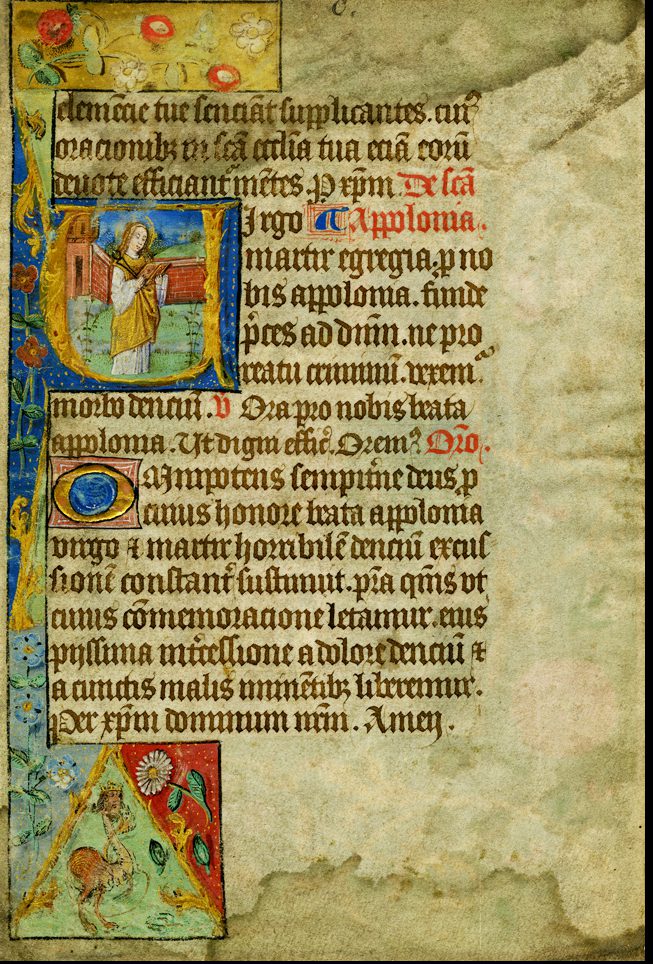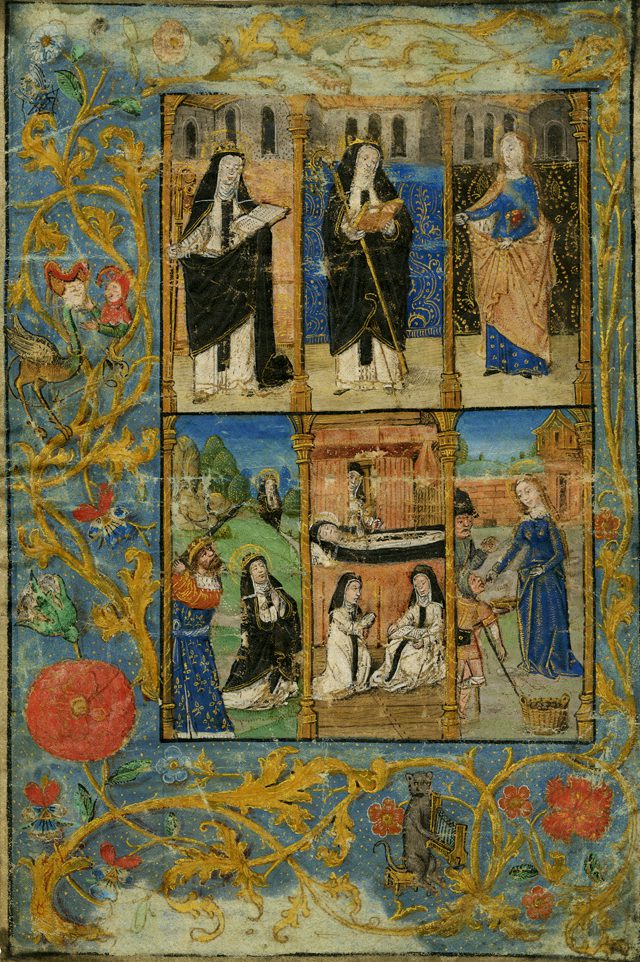Anna Lantz
Stockholm, Sweden
 |
 |
| Image of Saint Apollonia within the initial “V” of the prayer Virgo Apollonia. Parchment breviary, Flanders, c. 1400. Photo by Anna Lantz. | Six miniatures from the back side, none of which depicts Saint Apollonia. Parchment breviary, Flanders, c. 1400. Photo by Anna Lantz. |
Saint Apollonia was from a Greek family and lived in Alexandria, where she was martyred in the year 249 for refusing to renounce her Christian faith. On having her teeth pulled out and jaw shattered, she threw herself into the pyre that had been lit for her.1 During the Middle Ages she was one of several patron saints of diseases (sjukdomshelgon)2 who would be invoked for protection against a disease or pain in a part of the body that reflected their martyrdom. People would therefore pray to Saint Apollonia when suffering from dental problems or toothache.3 Her cult spread from Alexandria across western Christendom, where altars and churches were dedicated to her and her relics were venerated.4 Icons of Apollonia served as reminders of her sacrifice and as a focus of prayer.5 She is easily recognized by her attributes: a halo and palm frond—designating her martyrdom—along with a pair of pincers holding a tooth and a pyre. Saints’ days were very important to the early church, and Saint Apollonia’s feast day was celebrated on February 9th.6
Possibly the oldest known image of Apollonia can be found in the Wessler collection in the Hagströmer Library, Karolinska Institutet. The picture is from an old parchment breviary (a kind of prayer book) created in a Dominican monastery in Flanders around the year 1400.7 The execution is very lavish, with handwritten text and decoration and details picked out in gold. The picture of Apollonia is contained within the initial letter of the prayer Virgo Apollonia.
References
- Eusebius av Caesarea, Eusebii Pamfili Kyrkohistoria VI (1877) 239.
- Wessler, John, Beskrivande förteckning över Tandläkarinstitutets i Stockholm Apollonia-samling (Stockholm, 1923) 8.
- Henriksson, Carl O, “S:ta Apollonia, martyr och skyddshelgon”, Svensk medicinhistorisk tidskrift vol. 1 suppl. 1 (1997) 145.
- Trönnberg, Gunnar, “S:ta Apollonia av Alexandria, tandläkarnas skyddshelgon”, Odontologiska Föreningens Tidskrift nr 1 (1943) 11.
- Henriksson, Carl O, “S:ta Apollonia, martyr och skyddshelgon”, Svensk medicinhistorisk tidskrift vol. 1 suppl. 1 (1997) 147.
- Farmer, David Hugh, The Oxford Dictionary of Saints (Oxford, 1992) 28.
- Wessler, John, Beskrivande förteckning över Tandläkarinstitutets i Stockholm Apollonia-samling (Stockholm, 1923) 10.
ANNA LANTZ, MA in art history, is Curator of Rare Books and Prints at the Hagströmer Medico-Historical Library, Karolinska Institutet in Stockholm.
Highlighted in Frontispiece Summer 2016 – Volume 8, Issue 3
Summer 2016 | Sections | Art Flashes

Leave a Reply